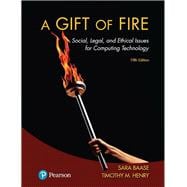For courses in Computer Ethics and Computers and Society.
An objective study of technology ethics that inspires critical thinking and debate
In Gift of Fire, A: Social, Legal, and Ethical Issues for Computing Technology, Sara Baase presents a balanced exploration of the social, legal, philosophical, ethical, political, constitutional, and economic implications of computing and the controversies they raise. With an objective computer scientist's perspective, and with historical context for many issues, Baase covers the issues readers will face both as members of a technological society and as professionals in computer-related fields. A primary goal is to develop computer professionals who understand the implications of what they create and how it fits into society at large. This text encourages readers to think about the ethics and philosophical direction behind topics but doesn’t them lead students to conclusions. The 5th Edition contains updated material on new topics and examples, outdated material has been removed, and several topics have been reorganized. New material appears throughout, including material on current trending topics such as drones and autonomous cars.










